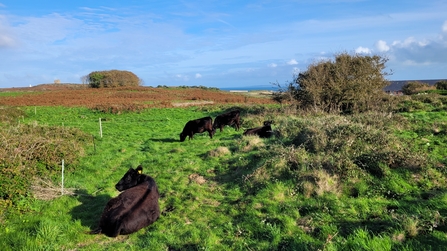You may have seen the six Guernsey/Angus cross steers borrowed from Kiln Farm Dairy, which make up our current herd, when enjoying the Longis Nature Reserve. But other than looking adorable, what benefits do they have to the area? Well, we use these cows for Conservation Grazing, a traditional method of managing grassland without the use of heavy machinery, and the herd has been a part of the AWT for twenty years now. This technique enables the land to become healthier and supports biodiversity!
Conservation Grazing Herd
Rowie Burcham

Rowie Burcham
Compared to other grazing species (such as sheep and goats), cows have larger mouths and use their tongues to wind around longer pieces of vegetation and pull them up, exposing the soil beneath. This creates and opens up habitats for other species to use. They also do this by increasing the structural diversity of the vegetation by trampling along the grassland and lying down. Furthermore, cows are also non-selective grazers, meaning they can enjoy vegetation across the reserve! This includes dominant plants, giving less competitive species a chance to grow. Their dung is also beneficial as it attracts insects which, in turn, draw in insectivorous bird species to the area. Finally, by grazing on plants, it allows these to regrow healthier than before and promoting a healthy landscape!

Rowie Burcham
As Longis Nature Reserve is a popular walking spot, the cattle are used to people. So next time you see them working hard (they are currently located near Mannez Football Pitch), say hello!

